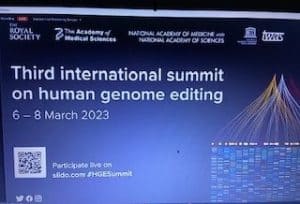16 March 2023
Louisa Ghevaert attended the Third International Summit on Human Genome Editing held at the Francis Crick Institute in London from 6 – 8 March 2023. The Summit was arranged by the UK Royal Society, UK Academy of Medical Sciences, US National Academies of Sciences and Medicine and the World Academy of Sciences. Its aim was to address the progress, benefits and challenges in research, regulation and equitable development of human genome editing technologies and therapies.
Discussions
The Summit took place as a hybrid event, with 400 in-person attendees from the global scientific, academic, medical and policymaker communities with a further 1,600 individuals attending online. It followed on from the Second International Summit on Human Genome Editing held in Hong Kong in 2018 and the first which took place in Washington DC in 2015. Its purpose was to facilitate a global discussion about the equitable use and regulation of somatic and germline genome editing, including developments in clinical trials to cure severe disease and genome editing tools such as CRISPR Cas-9.
The Summit opened debate about the use of human genome editing technologies, explaining that it could be of great benefit in improving human health and curing disease. In doing so, its development and use needed to be efficient, accurate, accessible and affordable. It also needed effective regulation and oversight to minimise the potential for it to be misused, for example in the the creation of “designer babies”.
The Summit discussions reflected on the fact that human genome editing technologies and therapies are an emerging area of science. Huge progress has been made in clinical trials in just a few years in the treatment of eye and blood disorders, rare genetic diseases and some cancers. In particular, human genome editing therapies now offer the promise of a cure for Sickle Cell Disease, an inherited blood disorder affecting millions worldwide. It affects the red blood cells causing severe pain, immobility, neurological and cognitive complications, organ damage and can render individuals infertile through the use of traditional treatments. It was reported at the summit that gene therapy has now changed the conversation for the treatment of Sickle Cell Disease from one of disease modification to a functional cure. The Summit then heard a moving and inspiring presentation by Victoria Gray, the first person to be cured of Sickle Cell disease in a US clinical trial using CRISPR gene-editing technology.
Scientific presentations at the Summit also reported latest research findings that the use of CRISPR Cas-9 gene-editing technology was not yet accurate or safe for clinical use to edit human embryos (a form of heritable genome editing). Latest research findings showed that CRISPR Cas-9 editing of human embryos continued to throw up lots of issues because embryos are poor at repairing a double strand DNA break. As such, further research was needed using other forms of genome editing technology (for example base and prime editing techniques) that do not require double strand DNA breaks in embryos to get better results for clinical use.
Discussions at the Summit also focused on regulation of human genome editing technologies and the steps that need to be taken to ensure effective use and oversight given the very high associated costs of gene therapies which can cost millions for each individual treated. In doing so, discussions focused on international equity in human genome editing. There were also sessions on the role of civil society in the research agenda and the importance of involving patient advocacy groups to understand what it is like to live with a genetic disease and help inform developments in research. In addition, there were sessions on regulation and policy approaches to increase accessibility for somatic (non-heritable) genome editing, including ethical considerations and enforcement.
Conclusions
The final statement from the organising committee of the Third International Summit on Human Genome Editing offered the following conclusions following 3 days of considered and inclusive discussions:
“Remarkable progress has been made in somatic human genome editing, demonstrating it can cure once incurable diseases. To realise its full therapeutic potential, research is needed to expand the range of diseases it can treat, and to better understand risks and unintended effects. The extremely high costs of current somatic gene therapies are unsustainable. A global commitment to affordable, equitable access to these treatments is urgently needed.
Heritable human genome editing remains unacceptable at this time. Public discussions and policy debates continue and are important for resolving whether this technology should be used. Governance frameworks and ethical principles for the responsible use of heritable human genome editing are not in place. Necessary safety and efficacy standards have not been met.
Governance mechanisms for human genome editing need to protect ongoing, legitimate research, while preventing clinics or individuals from offering unproven interventions in the guise of therapies or ways to avoid disease.”
How this technology is used and regulated requires informed public debate and decision-making. We need new law and policy frameworks to address its transformational capability as we increasingly have the capacity to change and control the human condition through gene editing technology. Law and policymakers need to address a range of economic issues around this technological revolution, including: price regulation, whether gene therapies should be free at the point of access, subsidised by the state or privately funded. There will also need to be debate about the costs of future investment in this rapidly evolving technology, revenue and profit generation, the commercial value of genomic knowledge, datasets and treatments.
It is also critical for future law and policy frameworks to tackle the dark side of gene editing technology and its relationship with national security and public health now and into the future. The wider application of gene editing technology has the capacity to be used for harm as well as good. The science is here now and a robust framework is therefore needed now.
Integrated multi-disciplinary success is within reach but only if we continue to widen and shift our paradigms and encompass all the evolving factors that form part of this multi-faceted picture. In doing so, this will require us to play close attention to how human gene editing technology is utilised in the treatment of genetic diseases and more widely.
For more information about genomics, fertility, family and wider law, policy and governance contact Louisa Ghevaert by email louisa@louisaghevaertassociates.co.uk or by telephone +44 (0)20 7965 8399.
Further Information
You can read more in my previous blogs:
“Human genome editing in a fertility context: The World Health Organization’s framework for governance of human genome editing” (Louisa Ghevaert Associates’ blog 29 July 2021).
“Human Genome Editing: World Health Organization & Global Governance” (Louisa Ghevaert Associates’ blog 22 September 2020).
“Human gene editing: from evolution to revolution? Why we need fertility and wider law reform part IV” (Louisa Ghevaert Associates’ blog 10 September 2020).
“Why we need fertility and wider law reform part II” (Louisa Ghevaert Associates’ blog 15 January 2020).







